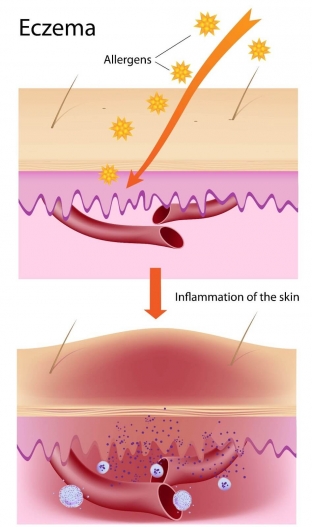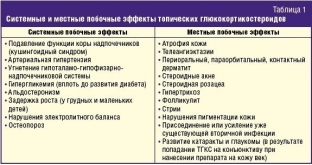Topical therapy for eczema must be carried out individually - depending on the characteristics of its manifestation in a particular patient, and also be complex - using different forms of drugs, which will help achieve stable remission and improve the patient's quality of life.
Eczema is a widespread skin disease that affects between 2% and 10% of the working population. It is one of the most common pathologies encountered in the practice of a dermatovenereologist, accounting for 30–40% of all skin diseases. What is eczema and what is the treatment principle for eczema?
What are the basic principles of eczema treatment?
 Eczema is a chronic relapsing disease with acute inflammatory symptoms caused by serous inflammation of epidermis and dermis, which is characterized by multifactorial genesis, variability of the clinical course with evolutionary polymorphism of rash elements, often with a tendency to severe course with frequent relapses and refractoriness to many treatments for eczema.
Eczema is a chronic relapsing disease with acute inflammatory symptoms caused by serous inflammation of epidermis and dermis, which is characterized by multifactorial genesis, variability of the clinical course with evolutionary polymorphism of rash elements, often with a tendency to severe course with frequent relapses and refractoriness to many treatments for eczema.
Taking into account the polyetiology of the disease, the treatment of patients with eczema implies a complex effect on the body with the development of a personalized algorithm for therapy and rehabilitation, taking into account the severity, nature, localization of the pathological process, the duration of the disease, the previous treatment of eczema and its effectiveness, the patient's age and the presence of concomitant pathology .
Systemic treatment of eczema usually begins with an exacerbation of the disease and, taking into account all of the above, includes the complex use of desensitizing, antihistamines, psychotropic and immune drugs.
If necessary, correction of concomitant pathological conditions is carried out by the appropriate specialist doctors.
At the same time, the following processes are an obligatory and important part of the complex treatment of eczema:
- adequate external therapy aimed at eliminating pruritus;
- stopping allergic reactions;
- elimination of dry skin;
- prevention/elimination of secondary infection;
- stimulation of reparative processes;
- restoration of the barrier function of the skin.
Use of corticosteroids in the treatment of eczema
Eczema is a steroid-sensitive dermatosis, the treatment of which requires a suppressive effect on the cells of the immune system of the skin, with a high therapeutic effect from the use of topical glucocorticosteroids (TGCS), as a result of which they occupy a leading position among all drugs for the external treatment of eczema.
The therapeutic effect of THCS is due to their strong anti-inflammatory, vasoconstrictive, antiallergic and antiproliferative effects.
Unlike systemic drugs, TGCS have a number of advantages: high affinity for receptors; pronounced local anti-inflammatory activity; minimal systemic action, which is associated with their use for the treatment of eczema in low concentrations, and low bioavailability.

How can I avoid side effects from corticosteroids when treating eczema?
At the same time, TGCS are not without undesirable side effects, which is associated with the peculiarities of the mechanism of their pharmacological activity. The incidence of side effects from THCS in the treatment of eczema is determined primarily by the structure of the active substance, the content of halogen atoms, the strength of the anti-inflammatory activity and the duration of the drug.
In order to minimize the undesirable effects of THCS in the treatment of eczema, it is advisable:
- use strictly according to the instructions;
- use TGCS in the absence of effect from indifferent therapy;
- do not mix with other topical preparations;
- prescribe in short courses (continuous use in adults should not exceed 1 month, in children - 7-10 days), taking into account the location and severity of the disease;
- Use drugs with high efficacy and an optimal safety profile (determined by the benefit/risk ratio);
- apply the drug in a thin layer, without rubbing or massaging;
- use different methods of using TGCS.
- in pediatric practice, preference is given to non-halogenated topical steroids, which, unlike halogenated ones, can be applied to the face, skin folds, genitals;
- if secondary infection is suspected, combined TGCS containing antimicrobial components should be used;
- use the dosage form of THCS in accordance with the nature and localization of the inflammatory process.
There are several forms of administration of corticosteroids. Read our previous article on the features of the use of THCS in the treatment of eczema.






Add a comment